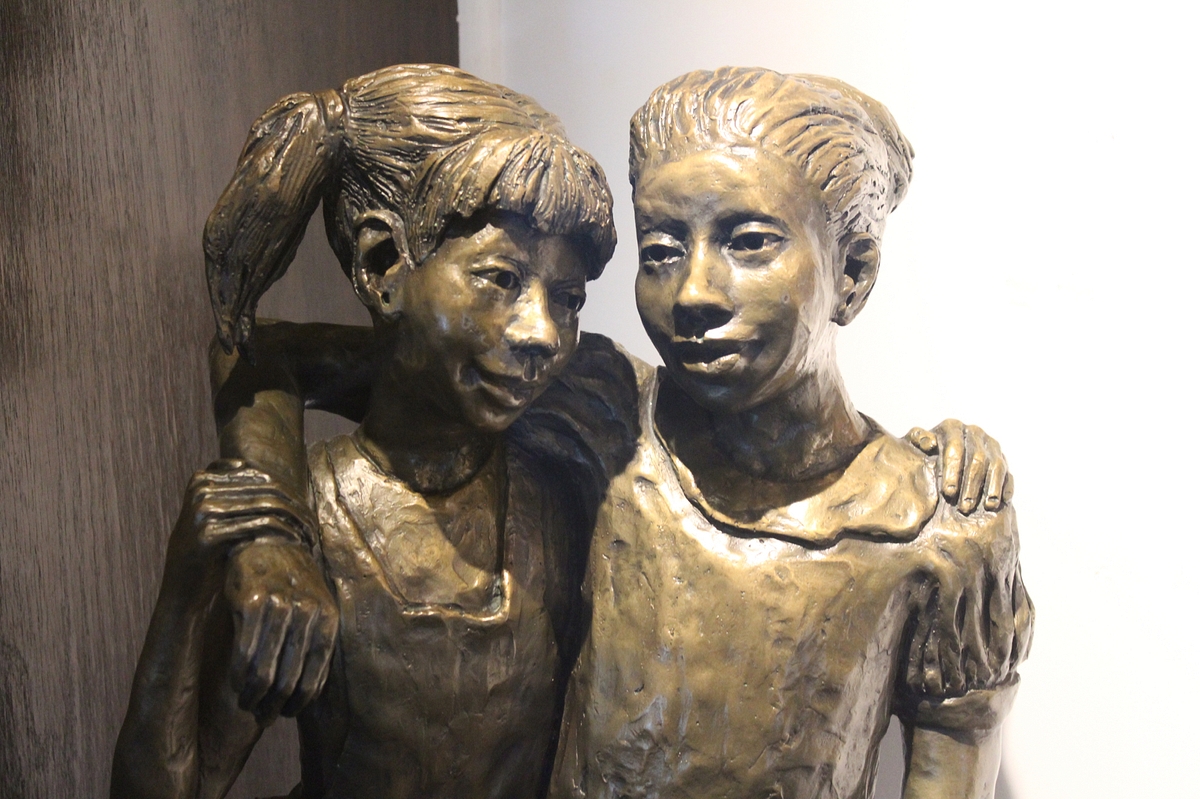
Linda Mickens
Sisters (detail).
Sisters is a sculpture that gets its effect in its details. Its creator, Linda Mickens, has the obvious skill to capture the girls as individuals, the contours of their faces, the wry, open expressions that are the gateway to seeing their personalities. Keeping the finest details a little vague has its own effect; it’s as though we’re seeing them in motion, just two girls walking down the street. What’s the nature of their kinship? Do they share a biological mother? Are they close friends? Or have they just met, but already feel a familial bond between them? The sculpture suggests the distinction is unimportant; what matters is that they’re sisters because they call each other that.
Sisters is part of “Seven Lenses: Documenting Black Culture,” curated by Shaunda Holloway and featuring the work of Robert Cooper, Lydia Douglas, Katrina Goldburn, Koren Martin, Ebony McKelvey, Linda Mickens, Wamaitha Ng’ang’a, and Jamel Shabazz. Running at the gallery at the Lyman Center for the Performing Arts at Southern Connecticut State University now through Mar. 4, the show, quietly and powerfully, offers a glimpse into an everyday extraordinariness.

Katrina Goldburn
Lucretia Was Here, 1638.
Part of that extraordinariness comes with an awareness of the past. In Katrina Goldburn’s Lucretia Was Here, 1638, the central figure haunts a typical street corner like a ghost; she’s just enough out of place to give the sense of something much larger going on. Jamel Shabazz’s Remembering the Ancestors, featuring drummers in joyous communion on a beach, captures a modern moment that surely has analogues to the distant past. That’s echoed in Koren Martin’s vivid photographs of musicians on the street and in the subway; they’re contemporary young people, dressed in the clothes of today, but the brass instruments they’re playing, and even the way they stand when they’re playing then, connects them to the music of a century ago. Other pieces bring out their subjects’ innate strength, shot through with struggle and defiance, as in Wamiatha Ng’ang’a rich illustrations and Ebony McKelvey’s high-definition photographs, which inhabit an evocative territory somewhere between a fashion shoot and a still from a film.

Jamel Shabazz
Father's Day.
This means that, with the links to the past and to the culture around them established, many of the other images in the show are able to draw their power from their ordinariness, almost like a family photo album. Lydia Douglas’s Jordan and Lauren could have been taking at a baseball game in the park, yet tell us much about their subjects’ interior lives. Shabazz’s Father’s Day lets us speculate on the relationship of father to kids, as Black people, yes, but in a broader sense as humans making their way through the world. That the photograph was taken decades ago adds a layer of speculation: where are these people now? Who have they become — children and adult alike — and what is their relationship with one another like?

Robert Cooper
Meriden Mountain.
Robert Cooper, meanwhile, infuses his photographs with a sense of the monumental. One features a Black man silhouetted against the spray of sea foam on a tumultuous shore. But Meriden Mountain brings it home even more, in its portrait of a man against a rock face. It holds its elements in balance. On one hand, he’s in a precarious place, perched on the edge of a cliff. On the other hand, the sky’s the limit.
“Seven Lenses: Documenting Black Culture” runs at the Lyman Center for the Performing Arts, 501 Crescent St., through Mar. 4. Admission is free and the gallery is open during normal business hours.